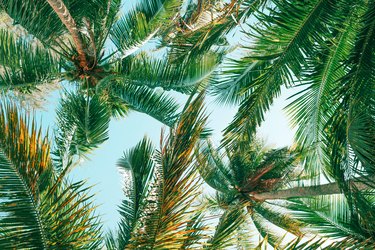
Appearing some 80 million years ago in the late Cretaceous Period, palms are an evergreen, semitropical plant that grows well in USDA hardiness zones 7 to 11, depending on species. Most of the over 2,500 different types of palm trees are tree-like, with single trunks and either fan-shaped (palmate) or feather-shaped (pinnate) compound leaves.
Where are palm trees native? There are several species indigenous to the continental United States, most of which are restricted to the warmer regions of southern United States, southern Florida and southern California. A number of imported exotic species have become naturalized with several being classified as invasive.
Video of the Day
Video of the Day
California Palm Trees
Are palm trees native to California? The California fan palm (Washingtonia filifera, USDA zones 9-11) is the only palm indigenous to the state and is now grown throughout subtropical climates worldwide. Potentially reaching 70 feet, with a crown spread of 15 feet, the massive, gray, barrel-shaped trunk can reach over 3 feet in diameter at its widest point, and is ringed with old leaf scars.
California fan palms can have up to 30 gray-green, fan-shaped leaves (palmate), each 3 to 6 feet across. These palmate leaves spread out to form a loose and open crown. The leaf stems (petioles) of mature California fan palms have curved thorns along the margins. A distinguishing characteristic of the California fan palm is the cotton-like threads on and between the leaflets that are present even on mature palms.
Washington Fan Palm
Native to the desert mountain valleys and canyons of Sonora and Baja Mexico, the Washington fan palm (Washingtonia robusta, zones 9-11) grows to over 100 feet and has a gray, 10- to 12-inch diameter trunk that bulges at the ground becoming more tapered as it reaches the crown of large, glossy, green palmate leaves with drooping leaflet tips. The leaves reach 5 feet in length and 4 feet wide. The 3-feet, orange leaf stems are edged with saw-tooth spines.
As the palmate leaves die, they fall against the trunk creating a "hula skirt" effect. This skirt of dry palmate leaves is a fire hazard and provides a home for rats and other undesirable creatures; as such, most California municipalities require that these dead palmate leaves be removed.
Large, light-beige, branched flower stalks (inflorescences) appear in the early summer, growing 7 to 10 feet long, with the flowers maturing into 1/2-inch black berries. The Washington fan palm is considered an invasive species by California Invasive Plant Council.
True Date Palm
One of the first cultivated plants in human history, the true date palm (Phoenix dactylifera, zones 9-11) is a native of northern Africa that can reach 100 feet when trimmed into a single stem specimen. The broad, gray trunk is patterned with diamond-shaped leaf scars. The leaves are 20 feet long by 2 feet wide, greenish or bluish-gray, feather-shaped (pinnate) and arranged in a thick, 40 feet-wide canopy. The 1.5-inch, yellow-orange to red fruit are oblong and have a large, pointed seed, surrounded by sugary flesh.
Dates are formed from flowers on 4 feet flower stalks (inflorescences) that emerge from among the leaves in spring. Male and female plants must be grown side by side in order to have the female plants produce dates. Other types of palms in this genus include pygmy date palm (Phoenix roebelenii, zones 10-11), Senegal date palm (Phoenix reclinata, zones 9-11) and the Canary Island date palm (Phoenix canariensis, zones 9-11).